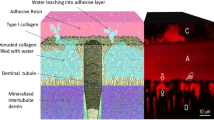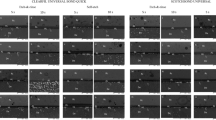Abstract
The conversion of medical resins in vivo occurs with increasing regularity, both in clinical practice and from a research perspective. In adhesive bonding for medical applications, most of these curing resin systems use a free radical polymerization mechanism to advance the chemical reaction and solidify the resin (1). Chemical conversion is usually accomplished by either a light activation system, which triggers the decomposition of an activator in the resin, or by direct chemical reaction, through mixing of components in a two-part system. Inhibition of the free radical polymerization by oxygen has been reported in the literature (1). Given that bony tissues, including dentin and other soft tissues, contain a substantial amount of water, the presence of water is ultimately an unavoidable circumstance in a large number of medical applications involving adhesives. Water is a key component of mineralized tissues, and cannot be readily removed without destruction of the tissue. Under ordinary circumstances, clean, dry surfaces are necessary for successful bonding. For longterm bonding in vivo, adhesives must successfully compete with water at the bond interface (2). How conversion has been affected by the presence of water has not been adequately characterized, but it has generally been considered a problem. Efforts have been undertaken to reduce the overall impact of water by drying the environment in which the resin application is performed (3).
Access this chapter
Tax calculation will be finalised at checkout
Purchases are for personal use only
Preview
Unable to display preview. Download preview PDF.
Similar content being viewed by others
References
Williams D. Concise Encyclopedia of Medical and Dental Materials, 1990; Pergamon, New York, NY, pp. 8–14.
Williams D. Biocompatibility of Dental Materials vol. 2, 1982; CRC, Boca Raton, pp. 96–100.
Craig RG, O’Brien WJ, and Powers JM. Dental Materials Properties and Manipulation 1979; C.V. Mosby, St. Louis, MO, pp. 28–37.
Craig RG. Dental Materials: a Problem Oriented Approach 1978; C.V. Mosby, St. Louis, MO, pp. 1.
Meurman JH and Helminen SKJ. Effectiveness of fissure sealant 3 years after application. Scand J Dent Res 1976; 84: 218–233.
Ismail AI and Gagnon P. Longitudinal evaluation of fissure sealants applied in dental practices. J Dent Res 1995; 74: 1583–1590.
Eliades E, Eliades G, Brantley WA, and Johnston WM. Polymerization efficiency of chemically cured and visible light-cured orthodontic adhesives: degree of cure. Am J Orthod Dentofac Orthop 1995; 108: 294–301.
Eversoll DK and Moore RN. Bonding orthodontic acrylic resin to enamel. Am J Orthod Dentofac Orthop 1988; 93: 477–485.
Thompson LR, Miller EG, and Bowles WH. Leaching of unpolymerized materials from orthodontic bonding resin. J Dent Res 1982; 61: 989–991.
Vaubert VM. Durability and Aging of Dental Fissure Sealants 1997; MS Thesis, Virginia Polytechnic Institute and State University, Blacksburg, VA.
Vaubert VM, Moon PC, and Love BJ. Extractable free monomers from self cured dental sealants resulting from dispensing errors. J Biomed Mater Res Appl Biomater 1999; 48: 5–8.
Editor information
Editors and Affiliations
Rights and permissions
Copyright information
© 2000 Springer Science+Business Media New York
About this chapter
Cite this chapter
Droesch, K.L., Love, B.J., Vaubert, V.M. (2000). Characterization of Water Inhibition in Light-Cured Dental Resins. In: Wise, D.L., Trantolo, D.J., Lewandrowski, KU., Gresser, J.D., Cattaneo, M.V., Yaszemski, M.J. (eds) Biomaterials Engineering and Devices: Human Applications . Humana Press, Totowa, NJ. https://doi.org/10.1007/978-1-59259-197-8_4
Download citation
DOI: https://doi.org/10.1007/978-1-59259-197-8_4
Publisher Name: Humana Press, Totowa, NJ
Print ISBN: 978-1-61737-227-8
Online ISBN: 978-1-59259-197-8
eBook Packages: Springer Book Archive




